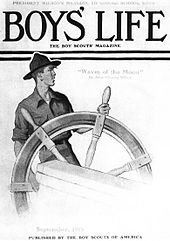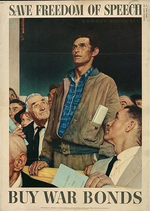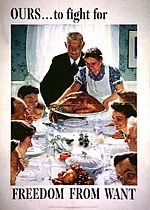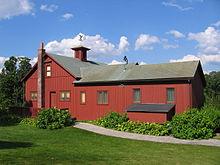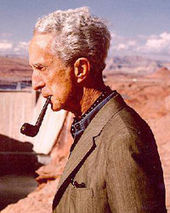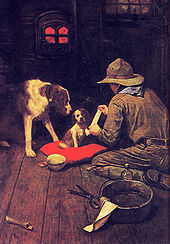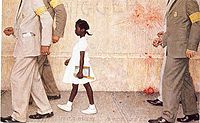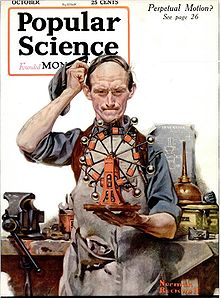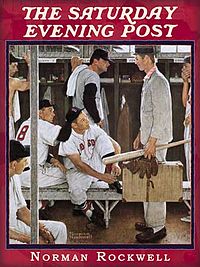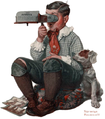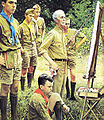- Norman Rockwell
-
Norman Rockwell 
Birth name Norman Percevel Rockwell Born February 3, 1894
New York CityDied November 8, 1978 (aged 84)
Stockbridge, MassachusettsNationality United States Field Painting, illustrator Training National Academy of Design
Art Students LeagueWorks Willie Gillis
Saying Grace
Four FreedomsNorman Percevel Rockwell (February 3, 1894 – November 8, 1978) was a 20th-century American painter and illustrator. His works enjoy a broad popular appeal in the United States for their reflection of American culture. Rockwell is most famous for the cover illustrations of everyday life scenarios he created for The Saturday Evening Post magazine for more than four decades.[1] Among the best-known of Rockwell's works are the Willie Gillis series, Rosie the Riveter (although his Rosie was reproduced less than others of the day), Saying Grace (1951), The Problem We All Live With, and the Four Freedoms series. He is also noted for his work for the Boy Scouts of America (BSA); producing covers for their publication Boys' Life, calendars, and other illustrations.
Contents
Life and works
Early life
Norman Rockwell was born on February 3, 1894, in New York City to Jarvis Waring Rockwell and Anne Mary "Nancy" (née Hill) Rockwell.[2][3][4] His earliest American ancestor was John Rockwell (1588–1662), from Somerset, England, who immigrated to America probably in 1635 aboard the ship Hopewell and became one of the first settlers of Windsor, Connecticut. He had one brother, Jarvis Waring Rockwell, Jr., older by a year and half.[5][6] Jarvis Waring, Sr., was the manager of the New York office of a Philadelphia textile firm, George Wood, Sons & Company, where he spent his entire career.[5][7][8]
Norman transferred from high school to the Chase Art School at the age of 14. He then went on to the National Academy of Design and finally to the Art Students League. There, he was taught by Thomas Fogarty, George Bridgman, and Frank Vincent DuMond; his early works were produced for St. Nicholas Magazine, the Boy Scouts of America (BSA) publication Boys' Life and other juvenile publications. Joseph Csatari carried on his legacy and style for the BSA.
As a student, Rockwell was given smaller, less important jobs. His first major breakthrough came in 1912 at age eighteen with his first book illustration for Carl Harry Claudy's Tell Me Why: Stories about Mother Nature.
In 1913, the nineteen-year old Rockwell became the art editor for Boys' Life, published by the Boy Scouts of America, a post he held for three years (1913–1916).[9] As part of that position, he painted several covers, beginning with his first published magazine cover, Scout at Ship's Wheel, appearing on the Boys' Life September 1913 edition.
World War I
During the First World War, he tried to enlist into the U.S. Navy but was refused entry because, at 6 feet (1.83 m) tall and 140 pounds (64 kg), he was eight pounds underweight. To compensate, he spent one night gorging himself on bananas, liquids and doughnuts, and weighed enough to enlist the next day. However, he was given the role of a military artist and did not see any action during his tour of duty.
Rockwell's family moved to New Rochelle, New York when Norman was 21 years old and shared a studio with the cartoonist Clyde Forsythe, who worked for The Saturday Evening Post. With Forsythe's help, he submitted his first successful cover painting to the Post in 1916, Mother's Day Off (published on May 20). He followed that success with Circus Barker and Strongman (published on June 3), Gramps at the Plate (August 5), Redhead Loves Hatty Perkins (September 16), People in a Theatre Balcony (October 14) and Man Playing Santa (December 9). Rockwell was published eight times total on the Post cover within the first twelve months. Norman Rockwell published a total of 322 original covers for The Saturday Evening Post over 47 years. His Sharp Harmony appeared on the cover of the issue dated September 26, 1936; depicts a barber and three clients, enjoying an a cappella song. The image was adopted by SPEBSQSA in its promotion of the art.
Rockwell's success on the cover of the Post led to covers for other magazines of the day, most notably The Literary Digest, The Country Gentleman, Leslie's Weekly, Judge, Peoples Popular Monthly and Life Magazine.
Personal life
Rockwell married his first wife, Irene O'Connor, in 1916. Irene was Rockwell's model in Mother Tucking Children into Bed, published on the cover of The Literary Digest on January 19, 1921. However, the couple were divorced in 1930. Depressed, he moved briefly to Alhambra, California as a guest of his old friend Clyde Forsythe. There he painted some of his best-known paintings including "The Doctor and the Doll". While there he met and married schoolteacher Mary Barstow.[10] The couple returned to New York shortly after their marriage. They had three children: Jarvis Waring, Thomas Rhodes and Peter Barstow. The family lived at 24 Lord Kitchener Road in the Bonnie Crest neighborhood of New Rochelle, New York. Rockwell and his wife were not very religious, although they were members of St. John's Wilmot Church, an Episcopal church near their home, and had their sons baptized there as well. Rockwell moved to Arlington, Vermont, in 1939 where his work began to reflect small-town life.[citation needed]
In 1953, the Rockwell family moved to Stockbridge, Massachusetts, so that his wife could be treated at the Austen Riggs Center, a psychiatric hospital at 25 Main Street, down Main Street from where Rockwell set up his studio.[11] Rockwell himself received psychiatric treatment from the renowned analyst Erik Erikson, who was on staff at Riggs. Erikson is said to have told the artist that he painted his happiness, but did not live it.[12] In 1959, Mary Barstow Rockwell died unexpectedly of a heart attack. In 1961, Rockwell married Molly Punderson, a retired teacher.
World War II
In 1943, during the Second World War, Rockwell painted the Four Freedoms series, which was completed in seven months and resulted in his losing 15 pounds. The series was inspired by a speech by Franklin D. Roosevelt, in which he described four principles for universal rights: Freedom from Want, Freedom of Speech, Freedom to Worship, and Freedom from Fear. The paintings were published in 1943 by The Saturday Evening Post. The United States Department of the Treasury later promoted war bonds by exhibiting the originals in 16 cities. Rockwell himself considered "Freedom of Speech" to be the best of the four. That same year a fire in his studio destroyed numerous original paintings, costumes, and props.
Shortly after the war, Rockwell was contacted by writer Elliott Caplin, brother of cartoonist Al Capp, with the suggestion that the three of them should make a daily comic strip together, with Caplin and his brother writing and Rockwell drawing. King Features Syndicate is reported to have promised a $1,000/week deal, knowing that a Capp-Rockwell collaboration would gain strong public interest. However, the project was ultimately aborted as it turned out that Rockwell, known for his perfectionism as an artist, could not deliver material as fast as required of him for a daily comic strip.[13]
During the late 1940s, Norman Rockwell spent the winter months as artist-in-residence at Otis College of Art and Design. Students occasionally were models for his Saturday Evening Post covers. In 1949, Rockwell donated an original Post cover, "April Fool," to be raffled off in a library fund raiser.
In 1959, his wife Mary died unexpectedly, and Rockwell took time off from his work to grieve. It was during this break that he and his son Thomas produced his autobiography, My Adventures as an Illustrator, which was published in 1960. The Post printed excerpts from this book in eight consecutive issues, the first containing Rockwell's famous Triple Self-Portrait.
Later career
Rockwell married his third wife, retired Milton Academy English teacher, Molly Punderson, in 1961. His last painting for the Post was published in 1963, marking the end of a publishing relationship that had included 322 cover paintings. He spent the next 10 years painting for Look magazine, where his work depicted his interests in civil rights, poverty and space exploration. In 1968 Rockwell was commissioned to do an album cover portrait of Mike Bloomfield and Al Kooper for their record, The Live Adventures of Mike Bloomfield and Al Kooper.[14] During his long career, he was commissioned to paint the portraits for Presidents Eisenhower, Kennedy, Johnson, and Nixon, as well as those of foreign figures, including Gamal Abdel Nasser and Jawaharlal Nehru. One of his last works was a portrait of Judy Garland in 1969.
A custodianship of his original paintings and drawings was established with Rockwell's help near his home in Stockbridge, Massachusetts, and the Norman Rockwell Museum is still open today year round. Norman Rockwell Museum is the authoritative source for all things Norman Rockwell. The Museum's collection is the world's largest, including more than 700 original Rockwell paintings, drawings, and studies. The Rockwell Center for American Visual Studies at the Norman Rockwell Museum is a national research institute dedicated to American illustration art.
When he was concerned with his health he placed his studio and the contents with the Norman Rockwell Museum, which was formerly known as the Stockbridge Historical society and even more formerly known as the Old Corner house, in a trust.
For "vivid and affectionate portraits of our country," Rockwell received the Presidential Medal of Freedom, the United States of America's highest civilian honor, in 1977.
Rockwell died November 8, 1978 of emphysema at age 84 in Stockbridge, Massachusetts. First Lady Rosalynn Carter attended his funeral.
Body of work
Norman Rockwell was a prolific artist, producing over 4,000 original works in his lifetime. Most of his works are either in public collections, or have been destroyed in fire or other misfortunes. Rockwell was also commissioned to illustrate over 40 books including Tom Sawyer and Huckleberry Finn. His annual contributions for the Boy Scouts' calendars between 1925 and 1976 (Rockwell was a 1939 recipient of the Silver Buffalo Award, the highest adult award given by the Boy Scouts of America[15]), were only slightly overshadowed by his most popular of calendar works: the "Four Seasons" illustrations for Brown & Bigelow that were published for 17 years beginning in 1947 and reproduced in various styles and sizes since 1964. Illustrations for booklets, catalogs, posters (particularly movie promotions), sheet music, stamps, playing cards, and murals (including "Yankee Doodle Dandy" and "God Bless the Hills", which was completed in 1936 for the Nassau Inn in Princeton, New Jersey) rounded out Rockwell's œuvre as an illustrator.
In 1969, as a tribute to Rockwell's 75th year birthday, officials of Brown & Bigelow and the Boy Scouts of America asked Rockwell to pose in Beyond the Easel, the calendar illustration that year.[16]
Rockwell's work was dismissed by serious art critics in his lifetime.[17] Many of his works appear overly sweet in modern critics' eyes,[18] especially the Saturday Evening Post covers, which tend toward idealistic or sentimentalized portrayals of American life— this has led to the often-deprecatory adjective "Rockwellesque." Consequently, Rockwell is not considered a "serious painter" by some contemporary artists, who often regard his work as bourgeois and kitsch. Writer Vladimir Nabokov sneered that Rockwell's brilliant technique was put to "banal" use, and wrote in his book Pnin: "That Dalí is really Norman Rockwell's twin brother kidnapped by Gypsies in babyhood". He is called an "illustrator" instead of an artist by some critics, a designation he did not mind, as it was what he called himself.[19]
However, in his later years, Rockwell began receiving more attention as a painter when he chose more serious subjects such as the series on racism for Look magazine.[20] One example of this more serious work is The Problem We All Live With, which dealt with the issue of school racial integration. The painting depicts a young African American girl, Ruby Bridges, flanked by white federal marshals, walking to school past a wall defaced by racist graffiti.[21]
In 1999, The New Yorker art critic Peter Schjeldahl said of Rockwell in ArtNews: “Rockwell is terrific. It’s become too tedious to pretend he isn’t.”[17]
Rockwell's work was exhibited at the Solomon R. Guggenheim Museum in 2001.[22] Rockwell's Breaking Home Ties sold for $15.4 million at a 2006 Sotheby’s auction.[17] A twelve-city U.S. tour of Rockwell's works took place in 2008.[9]
Influence
- In the film Empire of the Sun, a young boy (played by Christian Bale), is put to bed by his loving parents in a scene also inspired by a Rockwell painting—a reproduction of which is later kept by the young boy during his captivity in a prison camp. (Freedom from Fear, 1943).[23]
- The 1994 film Forrest Gump includes a shot in a school that re-creates Rockwell's "Girl with Black Eye" with young Forrest in place of the girl. Much of the film drew heavy visual inspiration from Rockwell's art.[24]
- Film director George Lucas owns Rockwell's original of The Peach Crop, and his colleague Steven Spielberg owns a sketch of Rockwell's Triple Self-Portrait. Each of the artworks hangs in the respective filmmakers' workspaces.[17] Rockwell is a major character in an episode of Lucas’ Young Indiana Jones Chronicles, “Passion for Life.”
- In 2005, Target Co. sold Marshall Field's to Federated Department Stores and the Federated discovered a reproduction of Rockwell's The Clock Mender, which depicted the great clocks of the Marshall Field and Company Building on display.[25][26] Rockwell had donated the painting depicted on the cover of the November 3, 1945 Saturday Evening Post to the store in 1948.[27]
- On Norman Rockwell's birthday, February 3, 2010, Google featured Rockwell's iconic image of young love "Boy and Girl Gazing at the Moon" which is also known as "Puppy Love" on its home page. The response was so great that day that the Norman Rockwell museum's servers went down under the onslaught.[citation needed]
- "Dreamland," a track from Canadian alternative rock band Our Lady Peace's 2009 album Burn Burn, was inspired by Rockwell's paintings.[28]
List of major works
- Scout at Ship's Wheel (first published magazine cover illustration, Boys' Life, September 1913)
- Santa and Scouts in Snow (1913)
- Boy and Baby Carriage (1916; first Saturday Evening Post cover)
- Circus Barker and Strongman (1916)
- Gramps at the Plate (1916)
- Redhead Loves Hatty Perkins (1916)
- People in a Theatre Balcony (1916)
- Tain't You (1917; first Life magazine cover)
- Cousin Reginald Goes to the Country (1917; first Country Gentleman cover)
- Santa and Expense Book (1920)
- Mother Tucking Children into Bed (1921; first wife Irene is the model)
- No Swimming (1921)
- Santa with Elves (1922)
- Doctor and Doll (1929)
- Deadline (1938)
- The Four Freedoms (1943)
- Freedom of Speech (1943)
- Freedom to Worship (1943)
- Freedom from Want (1943)
- Freedom from Fear (1943)
- Rosie the Riveter (1943) [2]
- Going and Coming (1947)
- Bottom of the Sixth (or The Three Umpires; 1949)
- Saying Grace (1951)
- The Young Lady with the Shiner (1953)
- Girl at Mirror (1954)
- Breaking Home Ties (1954)[29]
- The Marriage License (1955)
- The Scoutmaster (1956)[30]
- The Runaway (1958)
- Triple Self-Portrait (1960)
- Golden Rule (1961)
- The Problem We All Live With (1964)
- Southern Justice (Murder in Mississippi) (1965) [3]
- New Kids in the Neighborhood (1967)
- Russian Schoolroom (1967)
- The Rookie
- Spirit of 76 (1976) (stolen in 1978 but recovered in 2001 by the FBI's Robert King Wittman)
Gallery
See also
- James K. Van Brunt, a frequent model for Rockwell
- Four Freedoms (Norman Rockwell)
- Norman Rockwell's World... An American Dream, a 1972 short documentary film
- National Museum of American Illustration
References
- ^ About the Saturday Evening Post
- ^ Boughton, James (1903). Genealogy of the families of John Rockwell, of Stamford, Connecticut 1641, and Ralph Keeler, of Hartford, Connecticut 1939. W.F. Jones. p. 441.
- ^ Roberts, Gary Boyd, and David Curtis Dearborn (1998). Notable Kin: An Anthology of Columns First Published in the NEHGS Nexus, 1986–1995. Boston, Massachusetts: Carl Boyer in cooperation with the New England Historic Genealogical Society. p. 28. ISBN 978-0936124209.
- ^ Claridge, Laura P. (2001). Norman Rockwell: A Life. New York, New York: Random House. p. 20,29. ISBN 978-0375504532.
- ^ a b Rockwell, Margaret (1998). Norman Rockwell's Growing Up in America. Metro Books. pp. 10–11. ISBN 978-1567995985.
- ^ SSDI. – SS#: 177-01-3581.
- ^ Claridge. – p.30,47,150.
- ^ Rockwell, Norman, and Thomas Rockwell (1988). Norman Rockwell, My Adventures as an Illustrator. Abrams. p. 27. ISBN 978-0810915633.
- ^ a b "Rockwell and Csatari: A tour de force". Scouting magazine: 6. March–April, 2008.
- ^ City of Alhambra: A personal recollection
- ^ Norman Rockwell’s American Dream, by David Kamp, Vanity Fair, November 2009
- ^ [1]
- ^ Elliott Caplin: Al Capp Remembered (1994)
- ^ Kamp, David. "Erratum: Norman Rockwell Actually Did Rock Well". Vanity Fair. http://www.vanityfair.com/online/daily/2009/10/erratum-norman-rockwell-actually-did-rock-well.html. Retrieved February 24, 2011.
- ^ Official List of Silver Buffalo award Recipients (accessed July 17, 2007)
- ^ William Hillcourt (1977). Norman Rockwell's World of Scouting. New York: Harry N. Abrams. ISBN 0810915820.
- ^ a b c d Windolf, Jim; "Keys to the Kingdom"; vanityfair.com; February 2008
- ^ Solomon, Deborah, In Praise of Bad Art, The New York Times
- ^ Art of Illustration, Norman Rockwell Museum
- ^ Norman Rockwell Wins Medal of Freedom, Mass Moments
- ^ Miller, Michelle (November 12, 2010). "Ruby Bridges, Rockwell Muse, Goes Back to School". CBS Evening News with Katie Couric (CBS Interactive Inc.). http://www.cbsnews.com/stories/2010/11/12/eveningnews/main7049471.shtml. Retrieved November 13, 2010.
- ^ Norman Rockwell at the Solomon R. Guggenheim Museum.
- ^ Gates, Anita, Looking Beyond the Myth-Making Easel of Mr. Thanksgiving, The New York Times
- ^ Corliss, Richard, The World According to Gump, TIME
- ^ Aronovich, Hannah (April 20, 2006). "Field's, Federated and More Feuds". Gothamist. http://chicagoist.com/2006/04/20/fields_federated_and_more_feuds.php. Retrieved April 4, 2008.
- ^ "Norman Rockwell Of Field's Store Goes Missing". NBC5.com. April 21, 2006. http://www.nbc5.com/news/8882622/detail.html. Retrieved April 4, 2008.
- ^ Aronovich, Hannah (April 20, 2006). "Field's, Federated and More Feuds". Gothamist. http://chicagoist.com/2006/04/20/fields_federated_and_more_feuds.php. Retrieved September 21, 2009.
- ^ "Dreamland". Songfacts.com. http://www.songfacts.com/detail.php?id=19441. Retrieved May 5, 2010.
- ^ NRM, p. 109, http://www.nrm.org/page109.
- ^ Photos, Me, http://web.me.com/soderstrome/Norman_Rockwell/Photos.html.
Further reading
- Rockwell, Tom (2005). Best of Norman Rockwell. Courage Books. ISBN 076242415X.
- Finch, Christopher (1990). Norman Rockwell: 332 Magazine Covers. Abbeville Publishing Group. ISBN 0896600009.
- Christopher, Finch (1985). Norman Rockwell's America. Harry N. Abrams, Inc.. ISBN 0810980711.
- Buechner, Thomas S (1992). The Norman Rockwell Treasury. Galahad. ISBN 0883654113.
- Hennessey, Maureen Hart; Larson, Judy L. (1999). Norman Rockwell: Pictures for the American People. Harry N. Abrams. ISBN 0810963922.
- Gherman, Beverly (2000). Norman Rockwell: Storyteller with a Brush. ISBN 0689820011.
External links
- Rockwell Collection at The National Museum of American Illustration
- Norman Rockwell Museum, Stockbridge, Massachusetts
- Norman Rockwell WWII posters, hosted by the University of North Texas Libraries Digital Collections
- Gallery of classic graphic design featuring the illustrations of Norman Rockwell.
- Art Directors Club biography, portrait and images of work
- Norman Rockwell at Find a Grave
- America, Illustrated – by The New York Times
- Norman Rockwell: Once upon a time there Was the American Dream by Tiziano Thomas Dossena, Bridge Puglia USA, April 2011
- Footage of Norman Rockwell sketching a couple http://www.itnsource.com/shotlist//BHC_RTV/1925/08/18/BGT407101044/
Categories:- Norman Rockwell
- American magazine illustrators
- American painters
- Art Students League of New York alumni
- United States Navy sailors
- American military personnel of World War I
- Scouting in popular culture
- People associated with the Boy Scouts of America
- New Rochelle, New York
- People from New Rochelle, New York
- People from Stockbridge, Massachusetts
- Vermont culture
- Deaths from emphysema
- American people of English descent
- 1894 births
- 1978 deaths
- Parsons School of Design alumni
- Guggenheim Fellows
- American illustrators
- Artists from New York City
Wikimedia Foundation. 2010.

